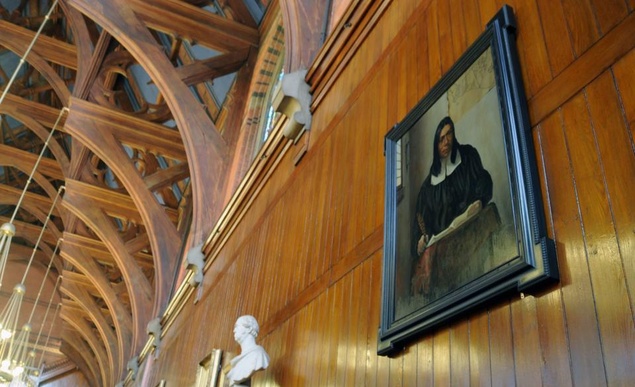WAMPANOAG, HARVARD AND CALEB

Next year is the 400th Anniversary the ship Mayflower landing at Plymouth, Massachusetts; the 384th Anniversary of the oldest college in America; and the 335th Anniversary of Caleb Cheeshahteaumuck’s graduation from Harvard. Who?
Every elementary school kid learns about the Mayflower and the Pilgrims as fall approaches and Thanksgiving arrives. Thank you Scholastic Magazine and others!
Millions of high school students from this county and around the world will write a college admissions essay of some kind this year. For many, the “reach college” will be Harvard. I mean, what’s the worst they can say? No.
And no one will know the name of Caleb Cheeshahteaumuck. Why should they?
Well it turns out, they might find him very interesting. Here’s why.
Caleb was the first Native America to graduate from Harvard and he was a member of the Wampanoag Nation. Of course, virtually no one knows what that is. They should.
The Wampanoag are the reason Charlie Brown is celebrating Thanksgiving.
Here’s the backstory.
When the Mayflower arrived from England in the fall of 1620, the passengers were really lost. Literally and figuratively. When they left for the “New World” their goal was to reach Virginia, which was already established as a thriving English colony, and had English people already there who were waiting and willing to assist them in getting started on this new continent. Their ship was sturdy enough, but the winds were unkind and blew them hundreds of miles off course. So far off that they ended up in today’s Plymouth Harbor, more than 600 miles north of Jamestown, Virginia. Provincetown was the first landfall, but the famous Rock was in Plymouth.
Once there, they knew they were in big trouble. By the following spring, half of the Pilgrims had died.
Luckily for the survivors, and all of us, they met the Wampanoag.
The Wampanoag were the indigenous people of Plymouth Harbor who helped the settlers survive the first year. The Thanksgiving Holiday we all celebrate was first held in the fall of 1621 when the Pilgrims realized they would survive in the New World thanks to the Wampanoag.
The Wampanoag were a blessing to the Pilgrims and all generations thereafter.
A few years later, a Wampanoag tribal chief had a son named Caleb Cheeshateaumuck, who was gifted.
In today’s world, he would get a full tuition scholarship based solely on academic merit to the college of his choice. Back then, Harvard was his only option. According to Harvard University’s Peabody Museum, Caleb passed the Harvard College entrance exams at around age 15. He learned Latin, studied Greek mythology and pondered the ancient philosophers. He excelled.
Caleb graduated in 1665, a year shy of Harvard’s 30th Anniversary.
He had a bright future, but not today’s medicine. He died shortly after graduation of tuberculosis, then called consumption.
We will never know what impact he could have had on American history. Tragically, shortly after his death tensions grew significantly between the native tribes of Plymouth Bay and the colonists, whose numbers had grown tremendously since 1620 with a desire for land occupied by the indigenous people of the region. King Philip’s War (1675-1676) was the eventual result. It has been describe as the bloodiest conflict per capita in American history.
As we celebrate the 400th Anniversary of Mayflower’s arrival in Plymouth, and the invaluable contributions of the indigenous Wampanoag People, we must also pause to celebrate the life of Caleb Cheeshahteaumuck, Harvard Class of 1665.
He was the inspiration for Geraldine Brook’s best-selling novel Caleb’s Crossing, which is the story of a “young man from Martha’s Vineyard” who “became the first Native American to graduate from Harvard College.”
J. L. Rose, the author of Before the Mayflower, considers Caleb’s achievement a tribute to the core values carried aboard the Mayflower and the intellectual prowess of the Wampanoag. “Education was highly valued by those traveling from England and Holland to the New World. Before setting sail, they spent eleven years in Leiden, a Dutch city 30 miles south of Amsterdam, considering their future and how best to carry the academic foundations of England and Holland to the New World. Caleb is confirmation that the Plymouth pioneers valued education and intellect from every corner of their community.”
Harvard University unveiled a portrait of Caleb Cheeshahteaumuck in 2010 . It is on display in Annenberg Hall, one of the most famous buildings on campus.
The events of four hundred years ago still resonate as America celebrates Indigenous People’s Day on October 14th. The nation’s core values truly stand the test of time.
–
Editor’s Note: Indigenous Peoples‘ Day is a holiday that celebrates the history and contributions of the indigenous peoples of North America. It is observed in the United States on the second Monday of October, thus coinciding with Columbus Day. It is celebrated in 23 states including New York, New Jersey, Pennsylvania, Connecticut, New Hampshire, Vermont, Massachusetts, Maine, Rhode Island, Maryland, Virginia, West Virginia and the District of Columbia.
